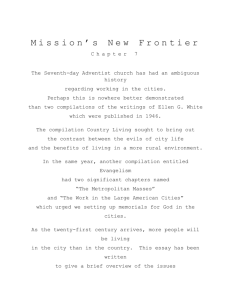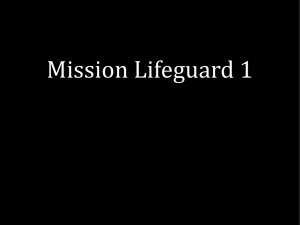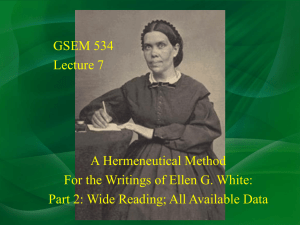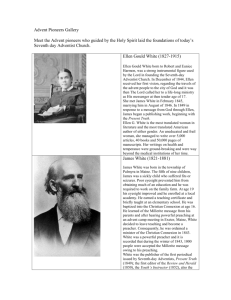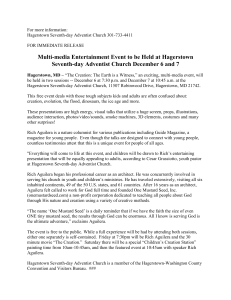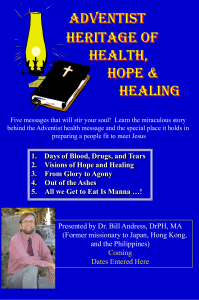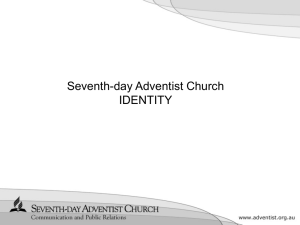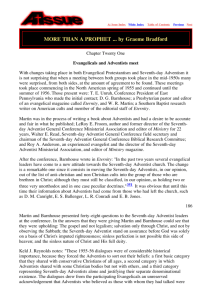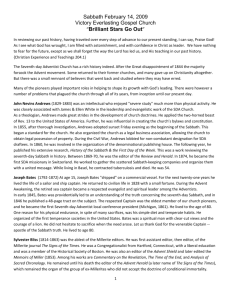CHIS_570 Syllabus
advertisement
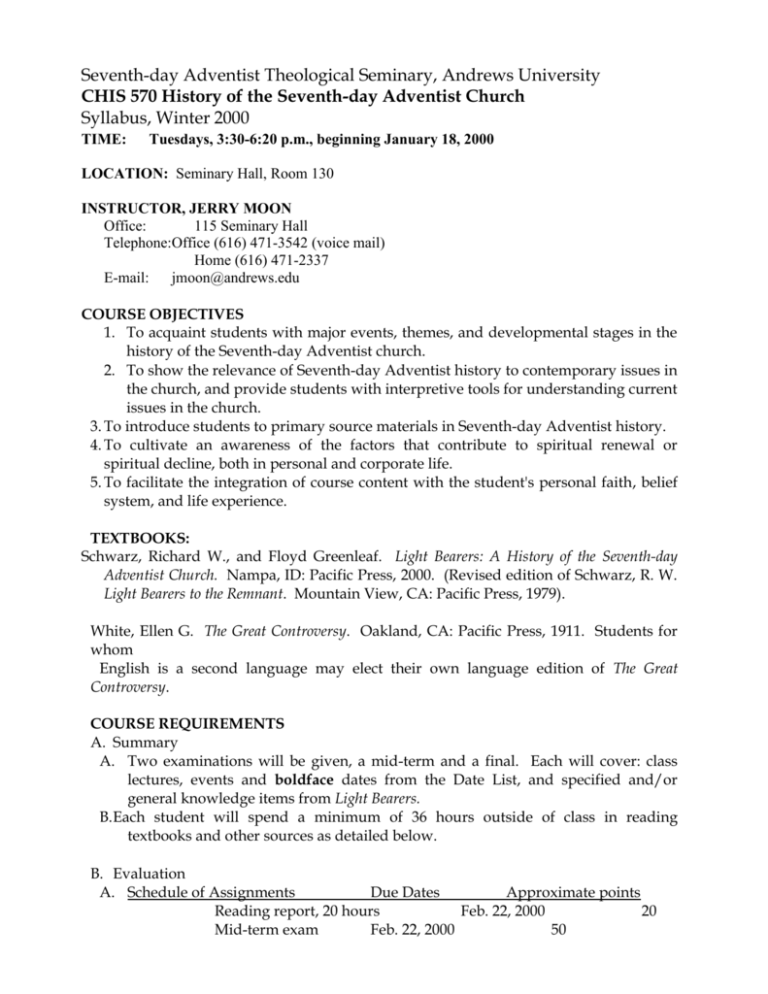
Seventh-day Adventist Theological Seminary, Andrews University CHIS 570 History of the Seventh-day Adventist Church Syllabus, Winter 2000 TIME: Tuesdays, 3:30-6:20 p.m., beginning January 18, 2000 LOCATION: Seminary Hall, Room 130 INSTRUCTOR, JERRY MOON Office: 115 Seminary Hall Telephone:Office (616) 471-3542 (voice mail) Home (616) 471-2337 E-mail: jmoon@andrews.edu COURSE OBJECTIVES 1. To acquaint students with major events, themes, and developmental stages in the history of the Seventh-day Adventist church. 2. To show the relevance of Seventh-day Adventist history to contemporary issues in the church, and provide students with interpretive tools for understanding current issues in the church. 3. To introduce students to primary source materials in Seventh-day Adventist history. 4. To cultivate an awareness of the factors that contribute to spiritual renewal or spiritual decline, both in personal and corporate life. 5. To facilitate the integration of course content with the student's personal faith, belief system, and life experience. TEXTBOOKS: Schwarz, Richard W., and Floyd Greenleaf. Light Bearers: A History of the Seventh-day Adventist Church. Nampa, ID: Pacific Press, 2000. (Revised edition of Schwarz, R. W. Light Bearers to the Remnant. Mountain View, CA: Pacific Press, 1979). White, Ellen G. The Great Controversy. Oakland, CA: Pacific Press, 1911. Students for whom English is a second language may elect their own language edition of The Great Controversy. COURSE REQUIREMENTS A. Summary A. Two examinations will be given, a mid-term and a final. Each will cover: class lectures, events and boldface dates from the Date List, and specified and/or general knowledge items from Light Bearers. B. Each student will spend a minimum of 36 hours outside of class in reading textbooks and other sources as detailed below. B. Evaluation A. Schedule of Assignments Due Dates Approximate points Reading report, 20 hours Feb. 22, 2000 20 Mid-term exam Feb. 22, 2000 50 Reading report, 21-40 hours Mar. 14-16 Battle Creek, Historic Adventist Village Final Exam Mar. 14-16 20 10 50 TOTAL 150 2. Grading will be based on the following scale (in % of points possible): A 95-100 C+ 70-74 A90-94 C 65-69 B+ 85-89 C60-64 B 80-84 D 50-59 B75-79 F 49 or below 5. Other factors that may affect grading: late papers or unexcused absences. a. Late work caused by illness should be verified by a note from the campus health center. Major emergencies unrelated to illness should be discussed with the instructor before the due date of the assignment. b. Any student unable to be present for an examination because of illness or any other emergency should notify the professor in advance. If no advance arrangements are made, the grade for the exam may be lowered. c. Seminary attendance policy allows no more than 3 absences per quarter for a 3-hour class. C. Reading report. The requirement is 40 hours of clock time spent in reading (textbooks and other secondary and primary sources as detailed below), reviewing class lecture notes, exam preparation, or a group project. Studying together is encouraged and recommended, provided there is a conscientious effort to distinguish between time on-task, which is reportable, and time off-task, which is not reportable. Standard: a reportable hour must include at least 50 minutes “on task.” In other words, an hour of study may include up to, but not more than, 10 minutes of exercise, social chatting, or other breaks. Method of reporting. The reading report should be kept up to date in diary fashion as study occurs, not reconstructed later from possibly faulty memory. It should include the student's name at the top of the sheet and an itemized account of how study time was spent, as follows: Date Time Time Description of Study Activity Hours Began ended Oct. 4 2:00 3:00 Schwarz, Light Bearers, 15-17, 24-54 1.0 Oct. 7 6:30 7:00 Review and Herald, 1850 0.5 Oct. 27 10:30 2:30 Study for mid-term exam 4.0 Total hours 5.5 At the bottom of the sheet, give the total number of hours, and (for the second report) the cumulative total of hours for the quarter. The first 20 hours will be due at the time of the mid-term exam, and the remainder at the time of the final exam. Partial credit will be given for partial completion of the assignment or for late reports not due to recognized emergencies. D. Some materials especially recommended: a. R. W. Schwarz, Light Bearers to the Remnant, is the main supplementary resource for examinable names and terms from the Date List or the Lecture Outline. Two methods of use may be particularly valuable: reading of selected chapters to the extent that time permits (story method), and use of the index to locate passages on specific issues (reference method). Each student will read at least 10 hours in Light Bearers. b. Ellen G. White’s The Great Controversy is highly recommended. Especially pertinent to this class are chapters 22-28 and 35-38. c. Arthur L. White’s 6-volume biography of Ellen G. White (Hagerstown, MD: Review and Herald, 1981-1986) is the best single source available for placing Ellen White’s writings in their historical context. Highly recommended for every SDA minister’s library. d. Databases. Two major CD-ROM databases of early Adventist primary sources are found in the James White Library--the Ellen G. White (EGW) and the Advent Pioneer Library (APL). Three advantages of using the electronic media are that (1) it saves wear and tear on the ancient originals; (2) documents are instantly accessible without having to be retrieved by research assistants; and (3) documents can be quickly printed without subjecting the originals to the photocopier. Microform documents offer a compromise between the speed of the electronic media and the "authenticity" of the originals. Students are encouraged to use electronic or film versions of the originals whenever possible, but especially when the originals are in poor condition. Each student may include in reading: a. Time spent reading or "browsing" on the APL. b. Time spent reading or "browsing" on the EGW CD-ROM. e. Periodicals. Each student will read a minimum of 2 hours total in the following: Millerite periodicals (especially recommended: Signs of the Times, Aug., 1, 1840, Midnight Cry or Advent Herald, August to October, 1844). Present Truth, 1849-50. Review and Herald, 1850-1903. Youth's Instructor, 1852-1940. Signs of the Times, 1886-1891. Message, 1935-1965. General Conference Bulletin, 1889-1903. f. Other Early Primary Sources Knight, George R., comp. and ed. 1844 and the Rise of Sabbatarian Adventism: Reproductions of Original Historical Documents. Hagerstown, MD: Review and Herald, 1994. Documents of major significance, with insightful explanatory introductions. Miller, William, any works Litch, Josiah, any works Fitch, Charles. Sin Shall Not Have Dominion Over You. Originally published in Guide to Christian Perfection, 1840; reprint: Brushton, NY: TEACH Services, Inc., 1995. Manuscripts and Memories of Minneapolis: Selections from non-Ellen White letters, articles, notes, reports, and pamphlets which deal with the Minneapolis General Conference Session. Boise: Pacific Press, 1988. White, Ellen G. 1888 Materials: Letters, Manuscripts, Articles, and Sermons Relating to the 1888 General Conference. 4 vols. Washington: Ellen G. White Estate, 1987. 7. More recent sources. Baker, Delbert W. The Dynamics of Communication and African-American progress in the Seventh Day Adventist Organization: A Historical Descriptive Analysis. Ph.D. Thesis, Howard University, 1993. Ann Arbor, MI: University Microfilms International. Baker, Delbert W., comp., in cooperation with the Black Caucus of SDA administrators. Telling the Story: an Anthology on the Development of the Black SDA Work. Loma Linda, CA: Loma Linda University Printing Services, 1996. A collection of historical documents, articles, and visuals on selected topics relevant to the Black SDA work. __________. The Unknown Prophet. Washington, DC: Review and Herald, 1987. The path-breaking biography of William Ellis Foy. Cleveland, E. E. Let the Church Roll On: The E. E. Cleveland Story: An Autobiography. Boise, ID: Pacific Press, 1997. Fordham, W. W. Righteous Rebel. Washington, DC: Review and Herald, 1990. Maxwell, C. Mervyn. Magnificent Disappointment: What Really Happened in 1844 and Its Meaning for Today. Boise: Pacific Press, 1994. A good resource for understanding the intricacies of the 2300-day prophecy. ________. Tell It to the World: The Story of Seventh-day Adventists. Several editions. Nampa, ID: Pacific Press, 1976, 1998. Moore, A. Leroy. Adventism in Conflict: Resolving the Issues that Divide Us. Hagerstown, MD: Review and Herald, 1995. Reynolds, Louis B. We Have Tomorrow: The Story of American Seventh-day Adventists with an African Heritage. Washington, DC: Review and Herald, 1984. 8. Videos. The Midnight Cry: William Miller and the End of the World Keepers of the Flame (8 half-hour programs) Three Angels Over Battle Creek 9. Other sources or projects may be included by approval of the instructor. CHIS 570 History of the Seventh-day Adventist Churc DATE LIST Dates in large bold type are examinable. Millerite Adventism 1816-1818 William Miller studies the Bible and Cruden's Concordance. 1818 Miller concludes that "in about twenty-five years the affairs of our present state would be wound up." 1831 Miller begins to preach. 1833 Falling of the stars. 1842 William Ellis Foy, a Millerite preacher of African-American descent, receives the first of four visions relating to the Advent movement. He faithfully carries out his commission. Oct. 22, 1844 End of the 2300 Days of Daniel 8:14. Doctrinal Formation (Sabbath-keeping, sanctuary-believing, Adventism) Oct. 23, 1844 Hiram Edson's insight in the cornfield. Dec. 1844 Ellen Harmon's first vision. Apr. 6, 1846 Ellen Harmon, "To the Remnant Scattered Abroad." Broadside; 250 copies; first "denominational publication." 1848-50 Doctrinal conferences (one in 1847, seven in 1848, six in 1849, ten (?) in 1850). Nov. 1848 "Seal of God" and "Print a Little Paper" vision(s), at Dorchester, Mass., study conference. July 1849-Nov. 1850 The Present Truth published. Sept. 1850 The Advent Review begun. [Note that it overlaps the Present Truth.] Name was changed in November to The Second Advent Review and Sabbath Herald. 1851 First ordination: Washington Morse Aug. 1852 NY. James White launches the Youth's Instructor. Headquarters settled at Rochester, 1854 First Tent Evangelism 1855 Review office moved to Battle Creek. Nov. 1855 "Sunset to sunset" decision. 1856 "Laodicean message" of Revelation 3, first applied to SDAs. Dec. 1856 ministry. "Dash to Waukon" (Iowa) to recall J. N. Loughborough and J. N. Andrews to 1858 "Great Controversy" vision, Lovett's Grove [now in Bowling Green], Ohio. 1859 "Systematic benevolence on the tithing principle" adopted at a general meeting of Sabbath keepers in Battle Creek. 1861-1865 United States Civil War. Development of Church Organization 1860 Name "Seventh-day Adventist" adopted, in order to legally incorporate the Seventh-day Adventist Publishing Association in Battle Creek. 1861 Local churches formally organized. Oct. 1861 Michigan Conference organization began (completed Oct. 1862). 1863 General Conference organized on May 21. Twenty delegates present from six conferences. John Byington is elected president, with executive committee of three. 1863 "Comprehensive Health Reform" vision on June 5, in home of A. Hilliard, Otsego, Michigan. (This was a Friday night. The date is sometimes given as June 6.) 1864 M. B. Czechowski sails for Europe. By 1867 he would organize a company of Sabbath keepers in Tramelan, Switzerland. 1865 "Health Institution" vision on Dec. 25 [God's Christmas present]. 1868 Camp meeting, Wright, Michigan. 1871 E. B. Lane becomes the first SDA minister to preach in the American South. 1872 Joseph Bates dies at the age of 80. 1872 G. H. Bell's school in Battle Creek, officially adopted by the denomination. 1874 June 4, Signs of the Times launched in California. The Pacific Press would be dedicated the next year in Oakland, California. 1874 September 15, J. N. Andrews sails for Europe. 1874 Battle Creek College opens (building would be dedicated in Jan. 1875). 1878-1895 Sunday law persecution (17 years). 1881 James White dies at the age of 60. 1882-1883 Battle Creek College closes for a year. 1885-1887 Ellen White in Europe. 1886 1887 The American Sentinel begins publication; became Liberty in 1906. D. M. Canright leaves the denomination. Crisis and Reorganization 1888 General Conference at Minneapolis, Minnesota. Studies on law and righteousness stir the denomination. W. C. White, acting GC president, divides North America into "districts." 1889 C. M. Kinney, first Black minister ordained by SDAs. 1891-1900 E. G. White in Australia 1894 Edson White and Will Palmer begin evangelizing Southern Blacks via the steamboat, Morning Star. 1895-1910 1894 American Medical Missionary College, Chicago, J. H. Kellogg, director. Australasian Union (the first union conference) organized. Departmentalized in 1897, it became the pattern for GC reorganization in 1901. 1896 Oakwood Industrial School opens. It would become a senior college in 1943. 1901 Reorganization of General Conference (began April 1 in Battle Creek). BC College moves to Berrien Springs and reopens as Emmanuel Missionary College. 1902 Feb. 18, Battle Creek Sanitarium and Hospital burns. Dec. 30, Review and Herald Publishing Association building burns. 1902-1907 Kellogg Crisis 1903 GC session in Oakland, California votes to move headquarters from Battle Creek. 1904 May 18-25, "Berrien Springs Meeting" [of the Lake Union Conference]. Summer, E. A. Sutherland and P. T. Magan found the school that became Madison College. Autumn, Drs. David and Mary Paulson found Hinsdale Sanitarium. 1905 1907 Loma Linda property purchased, School of Nursing organized. Young People’s Missionary Volunteer (MV) department organized. Dr. J. H. Kellogg disfellowshipped. 1910 College of Medical Evangelists opens at Loma Linda, chartered to grant M.D. 1913 Divisions of the General Conference organized. The World Church in the Twentieth Century 1914-1918 World War I 1915 Death of Ellen G. White, July 16. 1919 Bible Conference, Washington, DC. 1922 Ministerial Association formed, A. G. Daniells, secretary. 1923 Ministry magazine, L. E. Froom, editor 1929-1939 The Great Depression 1930s Accreditation of North American colleges. 1934-1936 Advanced Bible School, summers only, at PUC, forerunner of Seminary 1937-1960 Seminary established at Washington, DC, became Potomac University 1939-1945 World War II 1944 Regional Conferences voted (first seven organized 1945-1947) 1952 Bible Conference, Sligo Church, Washington, DC (Our Firm Foundation) 1957 Publication of Seventh-day Adventists Answer Questions on Doctrine (QOD). 1960 Emmanuel Missionary College plus Potomac University becomes Andrews University. 1962 College of Medical Evangelists becomes Loma Linda University. 1968 Finland and the Northern European Division request counsel on ordaining women 1970 Insight replaced Youth’s Instructor (founded 1852) 1974 NAD Bible Conferences 1975 GC Spring Meeting authorized ordination of women as local elders 1980 Glacier View Consultation examines Desmond Ford’s theology and prophetic interpretation Dallas GC session approves statement of 27 Fundamental Beliefs Walter Rea published allegations about Ellen White’s literary borrowing 1985 Vienna, Austria, GC session, first outside USA. 1990 Indianapolis GC session, denied full ministerial ordination to women, but authorized women ordained as local elders to perform all the functions of an ordained minister. 1995 Utrecht, Netherlands, GC Session. (1) Voted to deny the NAD motion to allow each division to decide for itself whether or not to ordain women to the ministry. (2) Voted the most far-reaching restructuring of GC governance structure and GC session representation since 1901. 2000 Toronto, Canada, GC session. First session under new rules of representation. GENERAL CONFERENCE PRESIDENTS 1863-1865 1865-1867 1867-1869 1869-1871 1871-1874 1874-1880 John Byington James White J. N. Andrews James White G. I. Butler James White 1880-1888 G. I. Butler 1888-1889 W. C. White, Acting Pres. 1889-1897 O. A. Olsen 1897-1901 G. A. Irwin 1901-1922 A. G. Daniells 1922-1930 1930-1936 1936-1950 1950-1954 1954-1966 1966-1979 W. A. Spicer C. H. Watson J. L. McElhany W. H. Branson R. R. Figuhr R. H. Pierson, Resigned for health reasons 1979-1990 N. C. Wilson 1990-1999 R. S. Folkenberg 1999 G. Ralph Thompson, President 1999- Jan Paulsen Acting

